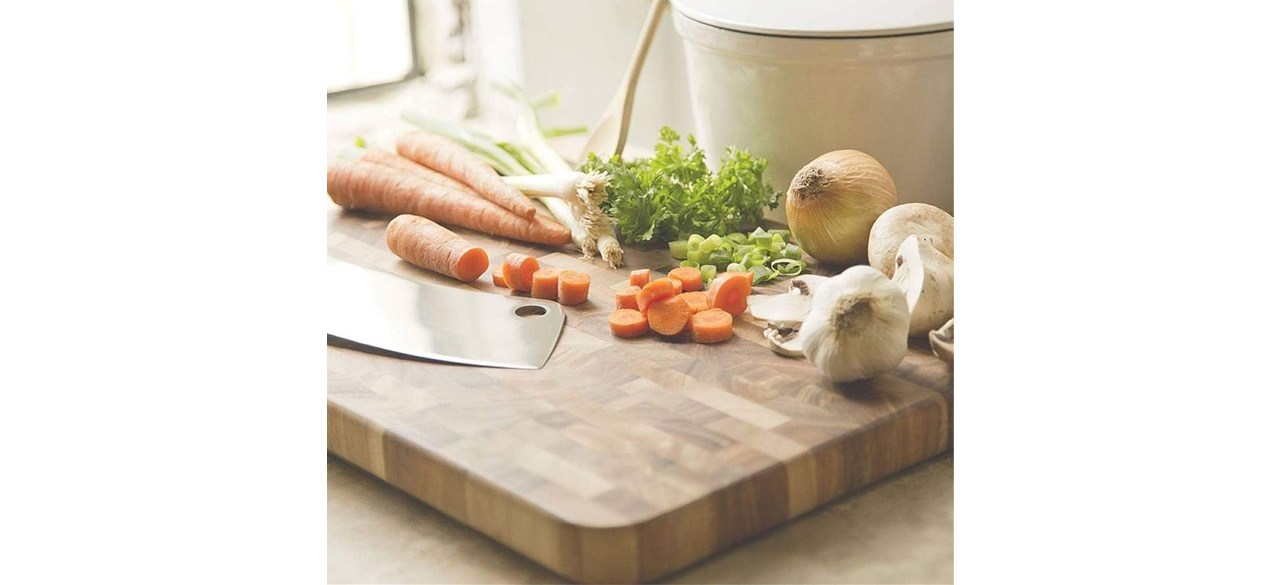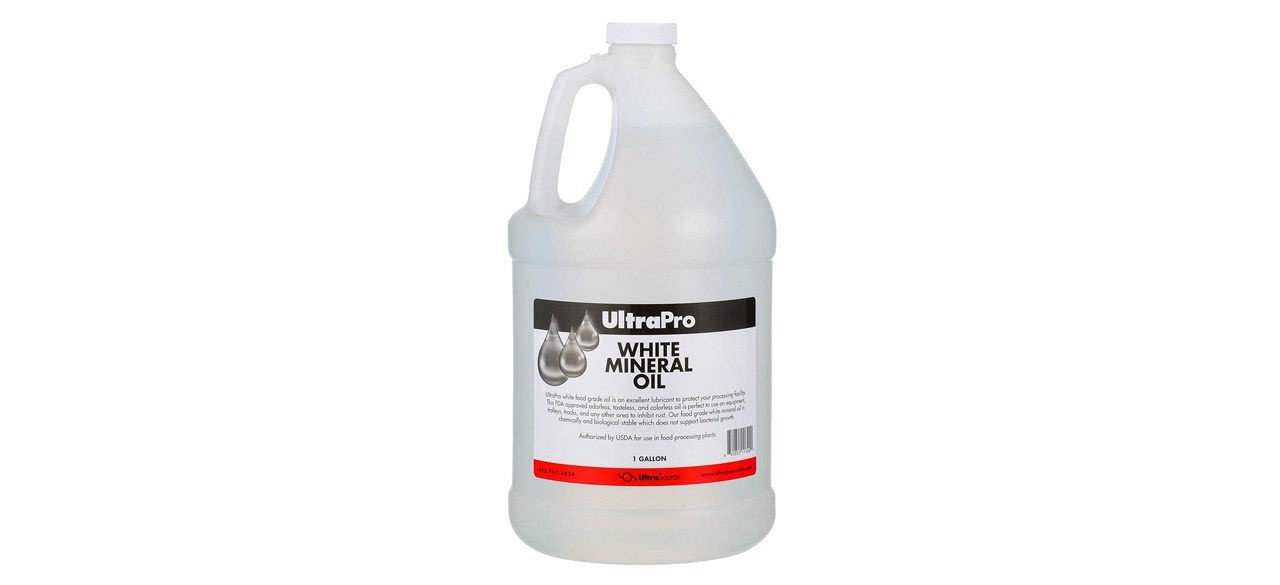More people are ditching their plastic cutting boards and going back to wood

BestReviews is reader-supported and may earn an affiliate commission. Details.
After a recent disturbing study, more people are going back to wood cutting boards
If you’re worried about exposure to microplastics, you may want to reevaluate your cutting boards. A recent study found that plastic cutting boards could be generating 15 milligrams of microplastics per cut, which adds up to 10 credit cards every year. With these numbers, it’s understandable that people want to switch back to wooden cutting boards. Howevever, wood comes with its own concerns. Here’s what to look for if you’re making the switch to a wood cutting board.
Shop this article: Caraway Cutting Board Set, John Boos Maple Cutting Board and Sonder Los Angeles Acacia Wood Cutting Board
Pros and cons of wooden cutting boards
There are some key differences between plastic and wood cutting boards, but even among wood boards, there are benefits and drawbacks. The kind of wood used, as well as the construction of the board, can affect both its perfomance and how safe it is.
Wooden cutting board pros
It’s hard to beat wooden cutting boards when it comes to appearance. Unlike plastic or rubber cutting boards, a wood board looks great on display on your countertop. Wood boards can be made from a solid slab or from joined strips (edge-grain) or cross-section pieces (end-grain) of wood. Each style has its own aesthetic and its own benefits. For example, solid pieces of wood are less absorbent and therefore less prone to odors, while end-grain wood is softer on knives.
In general, knife blades tend to stay sharper for longer when cutting on wood as opposed to plastic. The big exceptions are teak and bamboo, which are harder and stronger due to their high silica content. Silica is a key component of glass, and when it’s present in high amounts in your cutting board, it can wear out blades faster.
Wood boards, especially those made from end-grain pieces, are also naturally bacteria-resistant due to wood’s ability to draw bacteria deep into its interior, where it dies. Plus, end-grain wood boards are self-healing, meaning cuts have a tendency to close up on their own so they can’t harbor mildew and bacteria.
Wooden cutting board cons
A major concern regarding wood boards — and part of the reason plastic became so popular — is wood’s porosity. Wood is very absorbent, which means it can retain moisture and warp. Even worse, wooden boards can develop stains, odors and even bacteria that can lead to food-borne illnesses. Bamboo cutting boards are less porous and therefore less prone to harboring bacteria, but they’re also tough on knives.
Due to its absorbent material, wooden cutting boards require more upkeep than their plastic counterparts. They can’t simply go in the dishwasher: They need to be handwashed, and they benefit from monthly applications of mineral oil and wax. Should the board develop a crack or start splitting at its seams, it can develop dangerous bacteria, at which point it should be replaced.
Finally, wood cutting boards are quite pricey. Maple and walnut are popular picks due to their hardness, but they’re expensive. Teak and acacia are more affordable options, but even they are pricey compared to plastic.
How to clean wooden cutting boards
Plastic cutting boards can simply go in the dishwasher, but wooden cutting boards require more tender-loving care. If you take care of it correctly, though, your wooden board will last a lifetime.
The heat and saturation of a dishwasher can crack or warp wood, so wash your wooden cutting board (not to mention wood-handled knives and wooden spoons) by hand. Depending on what you use the board for, you may not need to wash it every time, but washing is essential after using it for raw meat. Use warm water and dish soap and be sure to wash both sides of the board — if one side is wet but the other is dry, the wood can warp. Let your board air-dry by standing it up on one edge or resting it in a rack.
Once it’s dry, you may want to oil and wax the board to protect it and make it look nice. Apply a layer of food-grade mineral oil to the entire board and let it soak into the wood for a couple hours. Next, use your hands or a lint-free cloth to rub a waterproofing wax board cream and let it soak in overnight. Make sure the board is standing upright so its faces can be exposed to air. Buff and polish the board the next day and your board will be ready to use. Repeat this process about once a month to extend your board’s lifespan and prevent warping.
Best wooden cutting boards

Thoughtfully designed with recessed indents for tools, cut-out handles and a groove to catch liquids, these birch cutting boards make kitchen prep easier and tidier. The boards are reversible and treated with food-safe mineral oil and wax.

Ironwood Gourmet End-Grain Acacia Cutting Board
End-grain wood is preferred in cutting boards because of its durability and natural resistance to bacteria. This acacia board is available in four sizes, with the option for a juice groove in the largest size.

Made from USA-sourced hardwood, this high-end board is hefty, measuring 1.75 inches thick. It’s reversible and comes pretreated with oil that protects both the board and your knives.

Sonder Los Angeles Acacia Wood Cutting Board
This thick, 1.5-inch board features a juice groove on one side and a cracker well for serving charcuterie on the other side. Side handles help make this board easier to lift.

This beautiful reversible board is made from sustainably sourced edge-grain teak and features a juice groove. Teak is a harder wood that resists knife marks — just be prepared to sharpen your knives a little more often.
Best wooden cutting board oil and wax

Boos Block Mystery Oil and Board Cream
Trusted in gourmet kitchens, this two-piece set protects wooden cutting boards and other implements from drying and cracking. Food-safe mineral oil and beeswax is easy to apply and helps protect boards from bacterial growth.

UltraPro Food-Grade White Mineral Oil
Polish and condition just about anything in your kitchen, from cutting boards to stainless steel surfaces, with this food-grade oil. It comes in a 1-gallon bottle, but since mineral oil doesn’t turn rancid, it’ll last a long time if properly stored.

Howard Butcher Block Conditioner and Cutting Board Oil
This time-tested formula includes beeswax, carnauba wax and food-safe mineral oil. Use both regularly to boost your cutting board’s water-resistance.
Prices listed reflect time and date of publication and are subject to change.
Check out our Daily Deals for the best products at the best prices and sign up here to receive the BestReviews weekly newsletter full of shopping inspo and sales.
Copyright 2023 Nexstar Media Inc. All rights reserved. This material may not be published, broadcast, rewritten, or redistributed. Regular the hill posts







